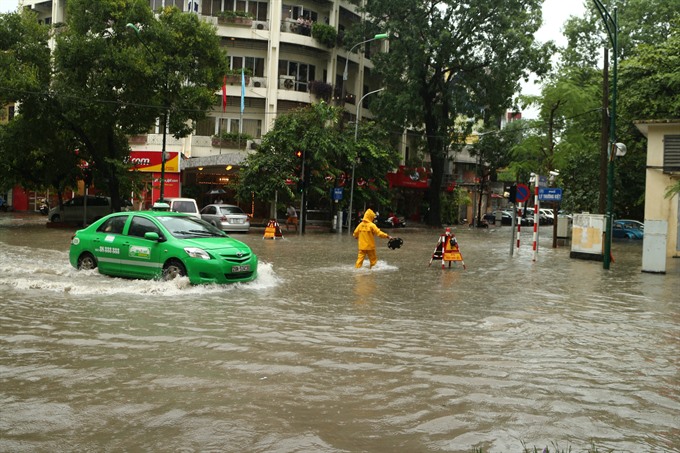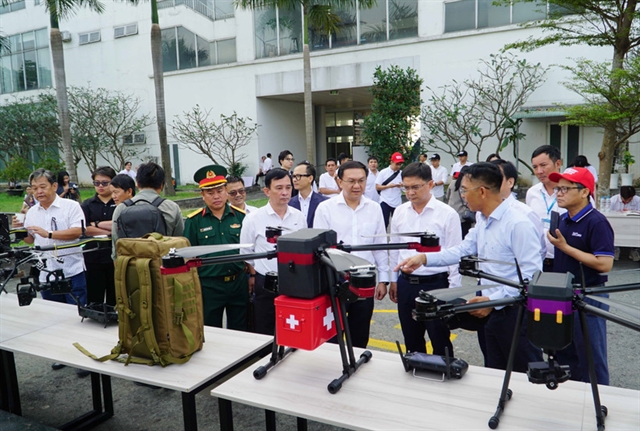 Society
Society

Eighteen locations in Hà Nội are at risk of flooding during the rainy season of this year since the city’s drainage system has been overloaded.
 |
| Lý Thường Kiệt Street in central Hà Nội was flooded during the rainy season last year. — VNS Photo Trương Vị |
HÀ NỘI — The capital city’s overloaded drainage system will struggle to cope with the rainy season this year, putting as many as 18 locations at risk of flooding, officials warn.
Hà Nội’s urbanisation process is happening so fast that the drainage infrastructure is unable to keep pace, said Võ Tiến Hùng, director of the Hà Nội Sewerage and Drainage Limited Company.
“It (the drainage system) works when there is 500mm of rainfall or less per two hours.
“But during extreme weather, rainfall can reach over 100mm in 40 minutes, overwhelming the system.”
Some 13-15 storms and tropical depressions are expected to occur during the season, according to the National Centre for Hydro-Meteorological Forecasting. Their patterns can prove difficult to predict, since this is the third consecutive year that the El Nino phenomenon is occurring in Việt Nam, the centre said.
Eleven of the eighteen locations highly likely to suffer flooding during prolonged downpours are located in the Tô Lịch River Basin, it said.
These it include the Phan Bội Châu – Lý Thường Kiệt intersection, the Đường Thành – Bát Đàn – Nhà Hoả – Cao Bá Quát intersection, as well as the streets of Đội Cấn, Thuỵ Khuê, Minh Khai, Nguyễn Chính, Thanh Đàm, Trường Chinh, Nguyễn Khuyến, and the stretch of Giải Phóng Street in front of the bus terminal.
Three other locations are in the Long Biên basin of the Red River, including the Ngọc Lâm Ward and the Hoàng Như Tiếp and Cổ Linh streets.
The four remaining locations are in the basin on the right banks of the Nhụê River, including the Hoa Bằng and Phạm Văn Đồng streets in Cầu Giấy District; and in the Hà Đông basin of the Red River, including the Quang Trung – Phan Đình Giót intersection and the area in front of the Yên Nghĩa Bus Station.
The locations in Hà Đông District will be especially hard to manage due to the lack of information on the district’s drainage system, said Lê Vũ Quảng Xương, vice director of the company.
“The previous management unit of the system, the Hà Đông Urban Environment Joint Stock Company, did not hand over the technical documents,” he explained. “Now we have to start over.”
Weak infrastructure
Inspections carried out by the city last year show that some of its irrigation constructions were built some 60-70 years ago with outdated technologies and equipment.
The Nhuệ River system from Ring Road 4 to Liên Mạc Ward in Bắc Từ Liêm District has not been dredged for a long time, and will be unable to drain water for inner-city areas and the districts of Hoài Đức and Đan Phượng, said Chu Phú Mỹ, deputy director of the city’s Department of Agricultural and Rural Development.
A majority of the 95 detention basins in the city have earth dams that have eroded and downgraded over time, and their water retention capacity is very weak, he said at a recent meeting with city leaders on natural disaster prevention and mitigation activities for this year.
Nguyễn Văn Sửu, Vice Chairman of the Hà Nội People’s Committee, said the city needs to prepare financial and human resources to respond to natural disasters in a timely manner.
Localities should inspect and review all dykes and locations that are prone to landslides and floods and report to the city before April 30, he said.
Remote sensing operations should be carried out and rescue teams should be on constant alert, he added.
Hidden dangers
Uncovered – or temporarily covered – manholes on the streets of Hà Nội are dangerous ‘traps’ for citizens during the rainy season, the Nông Thôn Ngày Nay (Countryside Today) newspaper reported.
In 2009, Trần Thị Mến in Tây Hồ District fell off her motorbike after running over an uncovered manhold on Lạc Long Quân Street. She died as a car ran over her.
Some 200 uncovered manholes were counted recently within the Hoà Bình residential area in Hà Đông District, threatening the lives of its residents, said the People’s Committee of Yên Nghĩa Ward. Most of manhole covers have been stolen and sold for money, it said.
A third grader recently fell into a manhole while learning how to ride a bicycle and lost two of his teeth, said Long, a district resident. “Some cars have got stuck in the holes, and drivers had to ask residents to help pull them out,” he told the newspaper.
Most of the manhole covers were made a long time ago and were not of uniform size of shape, said Bùi Thị Ngọc Lan, general manager of the Thiên Phát Import Export Limited Company.
“It is frustrating to see square covers being used for round holes,” she said. “It leaves the corners of the holes uncovered and makes it easy for the covers to be stolen.”
The causes of theft – as well as responsibility of local authorities in guarding and protecting their assets – should be investigated every time a cover is stolen, said Dr Nguyễn Văn Hùng, principal of the Thành Đông University.
“It’s a loophole in our country’s regulations when there are no measures to be taken and no one has to take responsibility in such situation,” he said. — VNS




